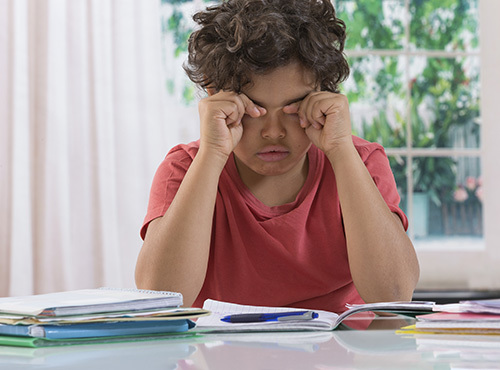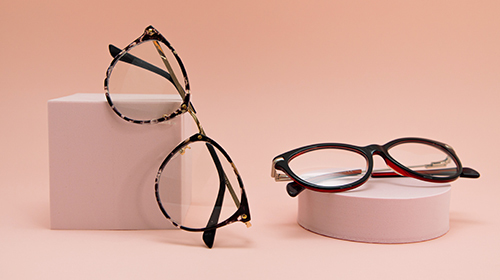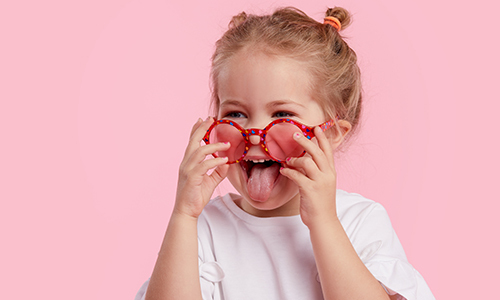The health of our kids is
the number one priority for parents. Kids glasses are a vital accessory for
children who require vision correction. Ensuring that your child has the right
pair of glasses can significantly impact their overall well-being and
development. In this article, we will explore the signs that indicate your child
may need an eye test and glasses, what to expect during their first eye test,
common eye conditions kids have, and essential tips for selecting the perfect
pair of children's glasses.
Additionally, we will check the various
features available for kids' glasses to help parents make an informed decision.
Signs Your Kid Needs Glasses
Ensuring your child's eye health is crucial, and recognizing the signs that your child may need glasses is the first step in that journey. Some common signs include:

- Squinting or tilting the head: Children who constantly squint or tilt their heads while reading or watching TV may be struggling to see clearly. This behavior is often an instinctive response to help them focus better.
- Frequent headaches or eye discomfort: Persistent headaches, eye strain, or discomfort, especially after activities that require concentration, can be an indication of vision problems.
- Holding objects too close or too far away: If your child consistently brings books or screens too close to their face or holds them at an unusually far distance, it could suggest nearsightedness or farsightedness.
- School performance: Children with uncorrected vision problems may have trouble reading the chalkboard or their textbooks, which can lead to academic difficulties.
- Frequent eye rubbing or excessive tearing: Kids who frequently rub their eyes or experience excessive tearing might be experiencing eye discomfort or irritation, possibly due to vision issues.
- Abnormal eye alignment: Check your child's eye position. If you notice that the eyes deviate outwards or towards the nose or elsewhere, then you need to see an eye doctor, it may mean that the child needs glasses.
The First Kids’ Eye Test
Before getting glasses for your child, it's essential to understand what to expect during their first eye test. This will not only help you prepare your child for the examination but also ensure that you are fully informed about the process. Here’s a brief summary of what to expect and how to prepare:
Pediatric Ophthalmologist*
First of all, you need to find the right doctor. Pediatric ophthalmologist are eye doctors who specialize in children's vision. They're experts in helping kids maintain healthy eyes and clear vision. When you visit them, their offices are designed to be kid-friendly, and they use special tests to make sure your child's eyes are healthy and seeing clearly.
Preparing Your Child
Preparing your child for their first eye test is essential to ensure a smooth and comfortable experience. Explain to your kid what will happen during the visit and reassure them that it's a routine and painless process.
The Eye Exam Process
During the eye exam, several tests are conducted to evaluate your child's vision and eye health:
- Visual Acuity Assessment: Your child will be asked to read an eye chart with rows of letters. This helps determine how clearly they can see objects at different distances.
- Checking the position and movements of the eyes: The eye specialist will assess whether the eyes are in a parallel position, or whether the eyes run towards the nose or outward when squinting, or whether the eyes do not vibrate during nystagmus.
Eye accommodation exclusion
At each initial examination of the child, accommodation with drops must be ruled
out so that the actual diopter values can be determined subsequently on the
autorefractometer. This allows the doctor to assess whether the child needs
glasses.
At the same time, drops used to eliminate accommodation dilate
the pupils, enabling the doctor to clearly examine the fundus of the eye,
including the optic nerve and the retina.
*Ophthalmologists and optometrists are both eye care professionals, but they have different roles in providing eye care. Ophthalmologists are medical doctors who can diagnose and treat a wide range of eye conditions, prescribe medication, and perform eye surgeries. They provide comprehensive eye care for all ages, including children. On the other hand, optometrists specializes in vision examinations and the application of contact lenses, he will recommend a suitable corrective aid for vision - glasses or contact lenses. An optometrist does not measure the vision of children under 15 years of age, the examination of children is always carried out by an ophthalmologist.
Choosing the Perfect Kid’s Glasses
Selecting the right frame and ensuring a proper fit is vital for your child's comfort and visual health. Consider the following factors when choosing kids' glasses:
- Glasses Size: Let's start with the fit. It's all about making sure those frames sit just right on your little one's face. Ensure that the bridge of the glasses fits comfortably on your child's nose. Look for frames with adjustable nose pads or keyhole bridges for a secure and comfortable fit. An optometrist can help you to find the right frame size tailored to your child's face shape and size.
- Prescription Accuracy: Ensure that the prescription lenses are accurately made to your child's specific needs. Regular eye exams are essential to keeping the prescription up to date as your child's eyes change over time.
- Frame Material & Durability: Kid's glasses must withstand an active lifestyle. Opt for durable materials like acetate, flexible plastics, or titanium frames. These materials are lightweight and perfect for daily wear.

By considering these factors when choosing your child's prescription glasses, you can ensure they have a comfortable, durable, and visually effective pair that suits their unique style and needs. Properly selected glasses will not only provide clear vision but also boost your child's confidence in wearing them.
Essential Features for Children's Glasses
UV filter protects young eyes from harmful UV rays, reducing the risk of eye conditions associated with sun exposure.
Glasses with extra hardening are less likely to break, which is particularly important for active kids.
Self-Cleaning coating minimizes smudges and makes cleaning the lenses easier, ensuring clear vision throughout the day.
Hydrophobic coatings repel water, preventing water droplets from obstructing vision during rainy weather.
Anti-reflective coating reduces glare from screens and artificial light sources, enhancing visual comfort during digital activities.
Kid's Sunglasses

Children's sunglasses are recommended only for extreme conditions, such as high-altitude environments, the seaside or upon the recommendation of an eye doctor. Just like adults, children need proper eye protection from ultraviolet (UV) rays, which can lead to eye conditions like cataracts and photokeratitis (a painful eye condition similar to sunburn).
Kid's sunglasses are designed with smaller faces in mind and come in a variety of fun colors and styles to encourage children to wear them. When shopping for kid's sunglasses, look for pairs that provide 100% UVA and UVB protection to shield their sensitive eyes from the sun's harmful rays.
Additionally, for active kids who enjoy swimming, sports, hiking, biking, or any outdoor activity, we offer a wide selection of sports sunglasses, swimming glasses and glasses for biking. Protect your kid's eyes in style, whether it's during sports, travelling, or any outdoor adventure!
Common Vision Problems in Children
Myopia (Nearsightedness)
Myopia is a common vision problem in children where distant objects appear blurry. It typically develops during school-age years and can progress over time. A sharp image in this defect appears in front of the retina. Regular eye exams are essential to monitor its progression and adjust prescriptions accordingly.
Amblyopia (Lazy Eye)
It is a functional vision defect that manifests itself as reduced visual acuity. It is caused by the abnormal development of vision, the cause of which is the absence or active attenuation of visual perception from the affected eye. It is treatable, but if it is not treated in time in childhood, a severe visual defect is fixed on the affected eye, which is permanent and cannot be removed in adulthood.
Hyperopia (Farsightedness)
Hyperopia makes it challenging to focus on close-up objects. A sharp image in this defect appears behind the retina. It can be present from a young age and may require corrective lenses to aid with reading and other close tasks.
Astigmatism
Astigmatism causes blurry or distorted vision due to an irregularly shaped cornea or lens. Children with astigmatism may experience difficulty with both near and distant vision. Corrective lenses can help provide clearer vision.
Strabismus
Strabismus (heterotropia) is a functional vision disorder that is externally accompanied by an asymmetric position of the eyes, the eyes can turn towards the nose or outward or up or down. In the treatment of pediatric squinting patients, the emphasis is on proper spectacle correction, treatment of amblyopia using occlusion therapy and special exercises, possibly surgery on the eye muscles.
Computer Vision Syndrome
With increased screen time, children are susceptible to computer vision syndrome, characterized by symptoms like eye strain, dryness, and discomfort. Encourage regular breaks, proper lighting, and the 20-20-20 rule (take a 20-second break every 20 minutes and focus on something 20 feet away) to mitigate these issues.
Remember
..prevention is the key. A well-balanced diet, regular physical activity, good sleep, fresh air and positive family bonds are the foundation of a healthy life, particularly for children. It's important to limit screen time and prioritize regular check-ups with a pediatrician. If refractive problems or strabismus are detected, it is crucial to promptly refer to an eye specialist and receive the necessary treatment.
Children and Contact Lenses
The use of contact lenses for kids is
possible when the child is mature enough to handle insertion, removal and proper
care of the lenses. The suitable age for contact lenses varies depending on
individual readiness, but it's typically recommended from the age of 15.
However, in cases of high refractive error or specific sports activities like
dance, football or skiing, contact lenses may be introduced earlier. Parental
cooperation and guidance are essential in this decision.

